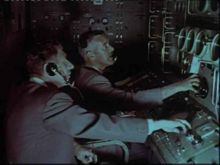SCR-584 Range-operator Instructions
| Revision as of 03:08, 28 February 2008 (edit) Paul (Talk | contribs) ← Previous diff |
Current revision (03:45, 23 November 2011) (edit) Paul (Talk | contribs) |
||
| Line 1: | Line 1: | ||
| - | '''Back to''' [[VERLORT Radar|Verlort Radar]] | ||
| <BR> | <BR> | ||
| - | + | {{SideMenuVerlortMain}} | |
| ---- | ---- | ||
| - | |||
| Extracted from the '''Mark 3''' and '''Mark 4''' sections of the '''USN WWII RADAR OPERATOR’S MANUAL''', April 1945. | Extracted from the '''Mark 3''' and '''Mark 4''' sections of the '''USN WWII RADAR OPERATOR’S MANUAL''', April 1945. | ||
| - | + | ---- | |
| Both these Marks are listed in '''US Radar-Operational Characteristics Classified by Tactical Situation''', August 1943. They are therefore contemporary with the '''SCR-584''' radar. | Both these Marks are listed in '''US Radar-Operational Characteristics Classified by Tactical Situation''', August 1943. They are therefore contemporary with the '''SCR-584''' radar. | ||
| Line 12: | Line 10: | ||
| ---- | ---- | ||
| - | [[Image:verlort-operators.jpg|left|thumbnail|180px|Muchea VERLORT operators at work. Don Blacman (foreground) trnsferred to the Carnarvon station:<BR>''Still taken from NASA film'']] | + | [[Image:verlort-operators.jpg|left|thumbnail|220px|Don Blackman (foreground) and Ken Lee (background) locking on.<BR> Don later transferred to the Carnarvon Tracking Station:<BR>''Still photo taken from a NASA film'']] |
| “The two greatest responsibilities of the range operator are: (1) to keep the pip in the notch, and (2) never to let it saturate (flatten on top due to too much receiver sensitivity). The pip must be kept in the center of the notch so that the pip appears even on the pointer's and trainer's scopes. If the pip saturates on the range scope, it will saturate on the trainer's and pointer's scopes, thus preventing them from knowing which way to train or elevate.” | “The two greatest responsibilities of the range operator are: (1) to keep the pip in the notch, and (2) never to let it saturate (flatten on top due to too much receiver sensitivity). The pip must be kept in the center of the notch so that the pip appears even on the pointer's and trainer's scopes. If the pip saturates on the range scope, it will saturate on the trainer's and pointer's scopes, thus preventing them from knowing which way to train or elevate.” | ||
Current revision
Back to VERLORT Radar
Extracted from the Mark 3 and Mark 4 sections of the USN WWII RADAR OPERATOR’S MANUAL, April 1945.
Both these Marks are listed in US Radar-Operational Characteristics Classified by Tactical Situation, August 1943. They are therefore contemporary with the SCR-584 radar.
The high degree of manual skill required by Range Operators is very evident.
“The two greatest responsibilities of the range operator are: (1) to keep the pip in the notch, and (2) never to let it saturate (flatten on top due to too much receiver sensitivity). The pip must be kept in the center of the notch so that the pip appears even on the pointer's and trainer's scopes. If the pip saturates on the range scope, it will saturate on the trainer's and pointer's scopes, thus preventing them from knowing which way to train or elevate.”
“One of the range operator's hands should always be on the range knob. When he wants to change range quickly, he should turn the range wheel with the small crank on it. For fine adjustment of range, such as keeping the pip in the notch, the operator should grasp the wheel with his hand and not use the crank. Usually this will be the right hand, but in some installations it may require the left.”
Extracts provided by Ken Anderson

